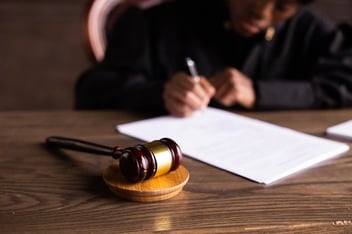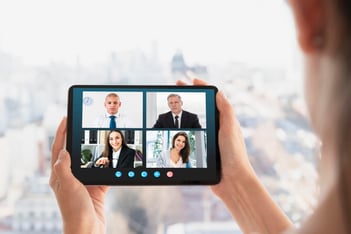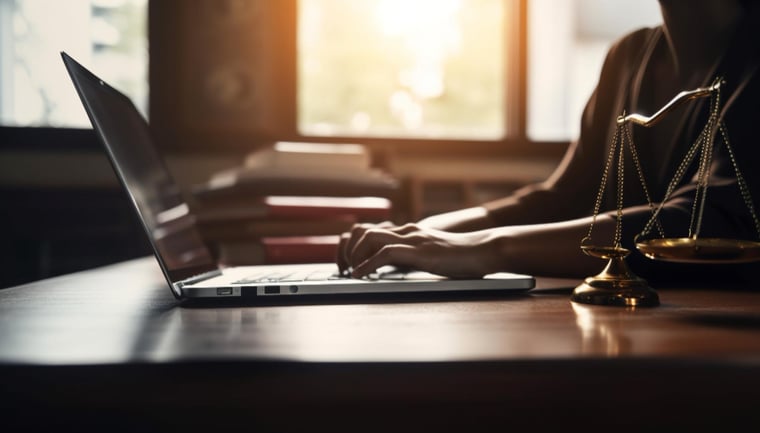artificial intelligence (AI) and video conferencing platforms into courtrooms.
This combination has streamlined and modernized court proceedings by improving efficiency and effectiveness in the legal landscape, improving the legal experience and increasing access to justice, no matter the location or financial situation. Let’s take a deeper look at how they have been used in courtrooms.
Read: Embracing Technology Transformations for Streamlined Operations at Law Firms
The Rise of AI in Courtrooms
AI has already found its way into many areas of the legal profession, including contract review and legal research. In courtrooms, AI plays a vital role in improving the efficiency and accuracy of legal proceedings, including:
- Court transcripts: An official record of all spoken words during a trial or hearing is vital to court records. AI transcription services listen and translate spoken words in real time before applying them to depositions and audio or video evidence. AI can also create a set of instant records of court activities and hearings that can be readily accessible for review.
- Translation: Language barriers are obstacles in court proceedings, and finding qualified interpreters can be time-consuming and expensive. AI concerts written formats into audio that aids illiterate and non-English-speaking witnesses, plaintiffs and defendants. This makes court proceedings more inclusive, so justice isn’t hampered by language barriers.
- Aiding judges: AI has been known to assist judges with evaluating briefs, conducting legal research and drafting rulings. Some Indian judges have used AI to summarize court law. All of these speed up the decision-making process and make it more efficient.
- Sentencing: AI can recommend bail, sentencing and parole/probation determinations based on various factors, including the likelihood of recidivism. With its recommendations, AI can reduce the disparities of human biases and subjective decision-making.
- Miscellaneous court tasks: AI can help court staff, judges and lawyers with a myriad of administrative tasks. For example, ChatGPT can draft legal documents, conduct legal research and predict case outcomes. Virtual court assistants and chatbots can assist with setting cases and answering questions.
Video Conferencing in Courtrooms
The COVID-19 pandemic forced courts worldwide to quickly adapt remote proceedings that would create a secure, inclusive environment. Video conferencing platforms created virtual hearings and trials, as they had many benefits:
- Easy accessibility: Video conferencing made it easier for lawyers, witnesses, experts and clients to participate in court proceedings regardless of location; as long as they had an internet connection and a webcam, they were in. This increased access to justice, especially for those with geographical barriers or who struggled to get time off for court.
- Cost savings: Virtual court sessions often require fewer resources and significantly reduced expenses associated with in-person hearings, such as travel and accommodation costs. If your court case is not in your hometown, you don’t have to pay for travel or an overnight stay at a hotel.
- Efficiency: Virtual hearings allowed for efficient scheduling and management of court proceedings. This caused more cases to appear in a day, reducing delays and pesky backlogs.
- Transparency: By recording virtual hearings, an accurate record of proceedings were available, making it valuable to appeals and review processes.
- More secure: To secure court cases, video conferencing platforms would implement waiting rooms where the host could allow or reject participants. Passcodes could also secure against unwanted people interrupting court hearings.
- Fewer interruptions: To avoid overlap or interruptions, hosts could mute participants and chats and require participants to “raise their hand” if they wished to speak.
Challenges and Concerns for AI and Video Conferencing
Although AI and video conferencing offer numerous advantages in the courtroom, they also bring forth some challenges and concerns:
- Lack of access to technology: Not everyone has access to the necessary technology equipment: microphones, cameras, lights, computers, etc. A stable internet connection is also required to access some AI and video conferencing platforms, which can limit their ability to participate in virtual court.
- Technical issues: Technical glitches, such as poor audio or video quality, can disrupt court proceedings and hinder effective communication between participants.
- Inability to correctly translate or transcribe: Though we listed AI’s assistance with translations and transcriptions as a benefit, there are concerns with its ability to do so accurately. Can AI translate idiomatic expressions or emotionally charged words? Can it understand content and nuance? Can it comprehend thick accents or hybrid languages, like Spanglish?
How Thriveon Can Help
Thriveon knows how significant AI is to revolutionizing how the legal industry works. Our fractional CIOs are building policies and strategies on how to implement AI and video conferencing platforms so our clients can leap ahead of the competition and work with ease. Our extensive work with Microsoft Teams allows us to implement the platform so you can create a modern work environment for seamless access and increased productivity and efficiency.
To see how this could work for your company, schedule a meeting with us today.

